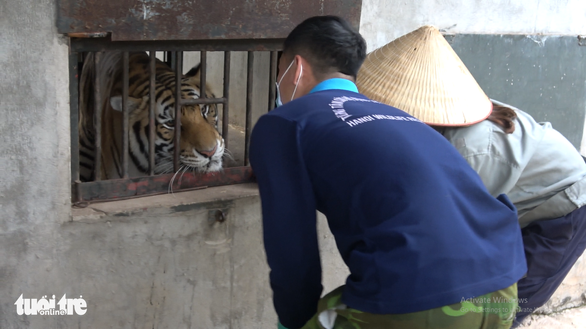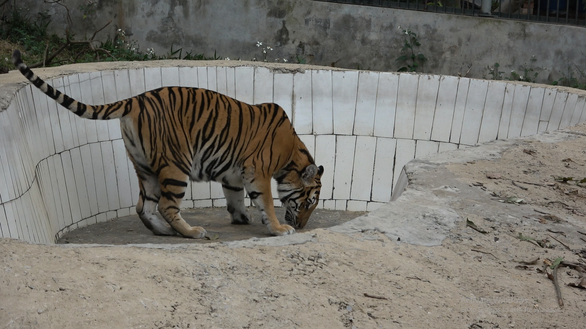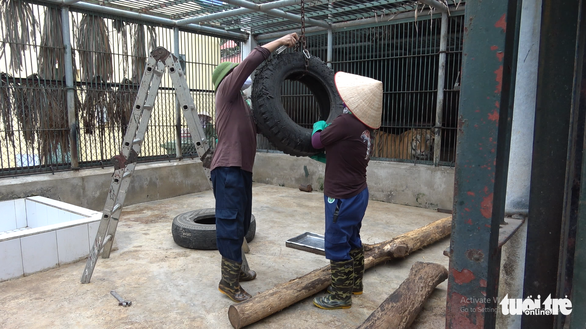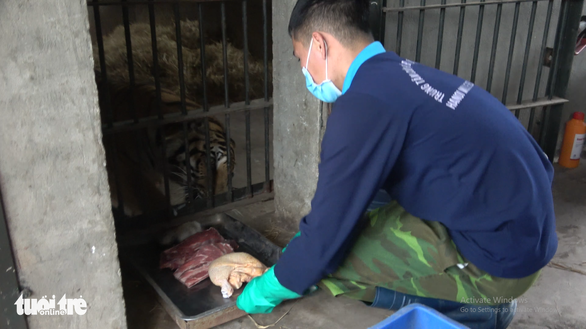Brave hearts, understanding, dedication, and excellent care from the caretakers at a sanctuary tucked away on the outskirts of Hanoi mean the tigers kept there, the country’s current largest ambush, are healthy and happy.
The Hanoi Wildlife Rescue Center, nestled in Soc Son District in the capital city’s suburbs, is always bustling with animal roars and commotion.
One of its prides is a 36-individual pack of tigers, the country’s largest.
The felines, rescued from illegal keepers and poachers, are thriving in the best possible conditions at this ‘home sweet home’.
Their caregivers, or dearly known as ‘nannies,' all work hard in the belief that all wild animals should have the ability to live the longest, healthiest, and best lives.
Beasts as ‘buddies’
The tigers and their caregivers make great friends and spend some ‘quality time’ together.
The beasts may look intimidating and behave aggressively toward strangers but they are just meek big cats in the presence of their caregivers.
They rub their heads gently against the iron fences of the enclosures, waiting for a pat on the heads from their human friends.
Though not allowed to roam free as in the wilderness, the big cats here are guaranteed protection, medical care, and a balanced diet.
The animals also have the company of veterinarians and caregivers, the trusted friends who have their back.
Vet Trinh Thi Thu Hang described the friendly relationship she has with the beasts by always addressing them as ‘buddies.”
|
|
| The magnificent tigers all thrive on good care and companionship provided by staff at the Hanoi Wildlife Rescue Center in Soc Son District, Hanoi. Photo: Tam Le / Tuoi Tre |
“Just like other animals kept at the rescue center, the tiger buddies are well tended to and carefully monitored. The procedures include enclosure cleaning, feeding, and medical care,” Hang said.
In addition to regular medical check-ups, the professional carefully checks on each of the tigers on a daily basis, paying attentjon to any sign of illness reported by the caregivers.
“The tiger buddies are easily prone to pneumonia and dermatophytosis [fungal infection of the skin] during this season. Fatigue or loss of appetite are telltale signs of ill health,” she noted.
The same affectionate address among the staff applies to all other animals which call the sanctuary home.
Apart from the ‘king of the jungle,' the center rescues and cares for more than 1,000 other individuals belonging to species listed in the International Union for Conservation of Nature (IUCN) Red List of Threatened Species and Vietnam's Red Data Book, a list of rare and endangered species of fauna and flora native to the Southeast Asian country.
As apex predators, tigers and bears are kept in well-cemented enclosures to ensure the caregivers are safe and the animals can still have some space of their own so they can frolic around with great vigor.
Nguyen Huu Nghia, a technician who has been on the job since the early days of the center, shares his daily work routines.
His working shift begins with him dipping his shoes into a tray of sterile water and entering the enclosures through the fences.
As soon as Nghia entered a large cage, something immediately caught his attention.
Noticing a rusty detail at one end of an iron fence bar, he asked a young staffer to replace it without delay.
Working every day with the predatory animals, most recognizable for their dark vertical stripes on shiny orange fur with a white underside, leaves the staff no room for error.
Nghia detailed the lengths he and his colleagues go to in order to ensure everyone’s safety.
|
|
| Two workers are pictured replacing the worn-out tigers’ toys, with their favorites including used car tires, logs or tree branches at the Hanoi Wildlife Rescue Center in Soc Son District, Hanoi. Photo: Tam Le / Tuoi Tre |
Each enclosure is partitioned into three chambers, with locked doors in between.
“When we want to clean this chamber or it’s feeding time, we lure the tigers into another and lock them up, so the keepers can do their job safely,” Nghia explained, affectionately referring to the beasts as ‘buddies’ all the time.
Parts of providing exceptional care are attending to the animals’ needs and getting them what they really need for better health and general well-being.
In winter, the streak is kept warm with straw and the ceiling is covered with light plastic sheets, while in summer, the sheets are retracted and the animals are kept cool by a moisture spraying system.
Each enclosure is home to two to three tigers, which all look healthy, vigorous, and friendly toward their caregivers.
A stranger until you know their name
To feel more connected and be more willing to invite the animals to feel the same, the center staff affectionately name each of the 36 tigers Vong, Vic, Ret, Xinh, and so on based on their distinctive physical, personality features and hobbies while lavishly doting on them.
“The 36 tigers all have different names and willingly reach the caregivers when hearing their names called,” Vet Hang said.
According to Hang, Vong (Circle) is recognizable for two circles running along his nose bridge; Ret (Centipede) has symmetrical stripes on his head while Xinh (Beauty) prides herself on a magnificent physique, round big ears, and a shiny soft coat.
There are eight tiger keepers in total, with two of them working together in one shift to ensure safety.
At Ret the Tiger’s enclosure, two workers were cleaning the outer chamber while another two were replacing his toys, including used car tires, logs or tree branches, which are designed to help the animals sharpen their claws.
The beasts sometimes roar and look uneasy when their toys are touched or they are in search of mates during the breeding season.
|
|
| With great caution, a caregiver feeds a tiger with a lavish serving of chicken, beef, and pig ribs at the Hanoi Wildlife Rescue Center in Soc Son District, Hanoi. Photo: Tam Le / Tuoi Tre |
Tigresses are kept separately in a semi-wild area where they have more open space. The separation helps avoid unwanted pregnancy.
Luong Que Thuy and her younger colleague, Nguyen Van Thao, have been on the job for seven years now.
There are 12 female tigers in total, according to Thuy, but their smaller physique does not mean they are less aggressive than their male counterparts.
No room for error
For their own safety and the animals’ well-being, the staff must remember well the seven lock clusters for the six enclosures.
Thuy said it is not too difficult to get to know the tigers.
“The animals are calm and are generally obedient and submissive unless provoked," Thuy shared.
“I often whisper sweet nothings to them when I’m feeding them or cleaning their cages."
Thao remembered how scared he was during his first days at work.
Now he knows the animals’ likes and dislikes like the back of his hand.
It was feeding time. Thao divided chicken, beef, and pig bones into equal servings.
Each tiger is fed twice a day with the sumptuous portion, including three kilograms of chicken, 1.5 kilograms of beef, and one kilogram of pig bones.
The food alone for each animal costs more than VND1 million (US$44) a day.
According to Thao, the caregiver puts the tray of food near the fence so the beasts can pull it inside.
“Great caution should be taken, as the animals can easily get excited at the sight of food and their predatory instincts can blur the line of friendship,” Thao said.
Technician Nghia shared one of his sweet memories with the tigers.
Around 13 years ago, the center welcomed three newborn cubs.
Nghia and another colleague took turns bottle feeding the cubs.
“Their milk bottles came every two hours, so we had to set alarms to get up at night and feed them during their first three months," Nghia said with a smile, adding all the three cubs are now healthy, fully grown tigers.
“I didn’t tend to my own newborns that much when my wife gave birth.”
Understanding and love for the animals
Luong Xuan Hong, director of the Hanoi Wildlife Rescue Center, shared that he and his staff have worked hard to give all the animals in captivity at his center better chances to re-wild.
He has made a lot of excursions to release some of the animals back into their natural habitat.
Hong said he also wants to re-wild the tigers, but no forests throughout Vietnam are able to protect them.
As an investigation conducted by Education for Nature – Vietnam revealed, the country was home to 16 registered tiger farms with 243 individuals as of May 2019.
The majority of these animals, however, are imported, with few pedigree Indochinese tigers believed to remain in the sanctuaries.
Tiger parts are widely used in traditional medicine, particularly in producing bone paste despite overwhelming scientific evidence that they have no beneficial value.
Relentless illegal wildlife trade and poaching make it even more difficult to restore the tiger population in Vietnam’s wilderness.
Like us on Facebook or follow us on Twitter to get the latest news about Vietnam!


















































